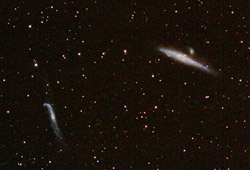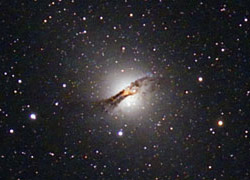This month we continue our tour of the Caldwell objects. The objects listed should be easily visible between the onset of darkness until at least 1 am unless otherwise noted. Some objects will be low on the southern horizon. If you missed the April objects, most if not all can still be viewed. Info can be found here.
 Caldwell 32 (NGC 4631, The Whale Galaxy) - [12h 42.1m, +32°32'] - C32 is a large, edge-on galaxy which is somewhat distorted. The distortion gives the galaxy a whale-like shape (hence the name). Look for the galaxy about 5.5 degrees from gamma Comae Berenices along a line between that star and Cor Caroli (the brightest star in Canes Venatici). In the same field of view, you are likely to see NGC 4656, the 'Hockey Stick'. Both are shown in the image on the right acquired by Steve Smith.
Caldwell 32 (NGC 4631, The Whale Galaxy) - [12h 42.1m, +32°32'] - C32 is a large, edge-on galaxy which is somewhat distorted. The distortion gives the galaxy a whale-like shape (hence the name). Look for the galaxy about 5.5 degrees from gamma Comae Berenices along a line between that star and Cor Caroli (the brightest star in Canes Venatici). In the same field of view, you are likely to see NGC 4656, the 'Hockey Stick'. Both are shown in the image on the right acquired by Steve Smith.
Caldwell 29 (NGC 5005) - [13h 10.9m, +37°03'] - NGC 5005 is a beautiful spiral galaxy in Canes Venatici. It's about 13 million light-years distant, but still has a clearly visible disc. Look carefully and you may also see one of it's many dust lanes. The galaxy is inclined at what I guessed to be at 50-60 degrees. Look for this gem just over 3 degrees ESE of Cor Caroli.
Caldwell 52 (NGC 4697) - [12h 48.6m, -5°48'] - A moderately bright elliptical galaxy in Virgo, NGC 4697 contains mostly older stars and few gas clouds. However, it images from the Chandra X-ray telescope detect a high abundance of x-rays emanating from near a super massive black hole at the galaxy's core. Find the galaxy about 5 degrees SSE of Porrima.
Caldwell 45 (NGC 5248) - [13h 37.5m, +08°53'] - C45 is a splendid spiral galaxy (much like C29) between Virgo and Bootes (though officially in Bootes). Its disc shows nicely and is inclined around 45 degrees. It's a bit tougher to find than the other targets on this month's list. The galaxy lies about 14 degrees SW of Arcturus and about 12 degrees ENE of Auva. Finding it will be a good test of your star-hopping skills, but you'll be nicely rewarded.
Caldwell 35 (NGC 4889) - [13h 00.1m, +27°59'] - The light you see when you observe NGC 4889 has been traveling across the cosmos for nearly a quarter of a billion years. C35 is a giant elliptical galaxy - the largest in the Coma Cluster. The galaxy will appear faint, but consider the distance. This is one of the most distant objects observable through a moderate-sized telescope. Find the galaxy about 2.5 degrees from beta Comae Berenices along a direct line toward gamma Comae Berenices. You'll likely see another giant elliptical galaxy in the same field of view, NGC 4874.
Caldwell 83 (NGC 4945) - [13h 05.4m, -49°28'] - Time to get down and dirty. C83 is an edge-on galaxy in Centaurus and from our latitude never gets more than around 8 degrees above the horizon. It's thought to be a barred spiral galaxy similar in size to our Milky Way. The galaxy is surrounded by dust which reduces its luminosity. In addition, you'll be viewing the galaxy through some of our own galaxy's dust further dimming the brightness. The galaxy is easy to find - it's about 4 degrees east of mag 2.8 gamma Centauri (the highest point on the centaur's back.
 Caldwell 77 (NGC 5128, Centauris-A) - [13h 25.5m, -43°01'] - Don't get up just yet. There's another, more well-known galaxy in Centaurus that you'll want to view. Centaurus-A. The galaxy much resembles an elliptical galaxy, except for the prominent dust band. C77 also emits strongly in radio frequencies. It is a most unusual galaxy. Find the galaxy about 4.5 degrees west of nu-Centauri.
Caldwell 77 (NGC 5128, Centauris-A) - [13h 25.5m, -43°01'] - Don't get up just yet. There's another, more well-known galaxy in Centaurus that you'll want to view. Centaurus-A. The galaxy much resembles an elliptical galaxy, except for the prominent dust band. C77 also emits strongly in radio frequencies. It is a most unusual galaxy. Find the galaxy about 4.5 degrees west of nu-Centauri.
Caldwell 80 (NGC 5139, Omega Centauri Cluster) - [13h 26.8m, -47°29'] - Still not time to get up. Aim your scope 4.5 south of Centaurus-A, and arrive at the most spectacular globular cluster in the Milky Way - Omega Centauri. This is a naked eye object (mag 3.7). Binoculars reveals the globular cluster nicely. A moderate-sized telescope will show the cluster's splendor. Put a big dob on the cluster and you'll feel like you're walking through the cluster.
You can get up now. This month's tour is finished.

